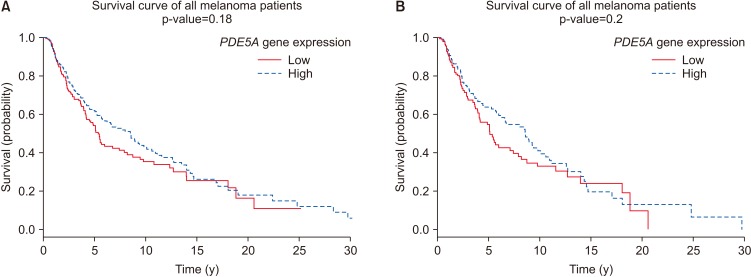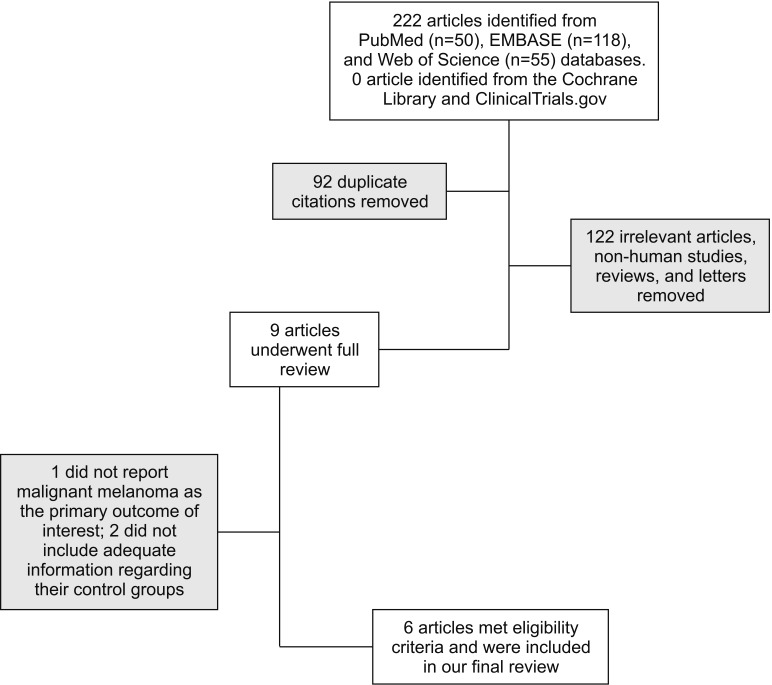World J Mens Health.
2019 Sep;37(3):313-321. 10.5534/wjmh.180050.
No Causal Link between Phosphodiesterase Type 5 Inhibition and Melanoma
- Affiliations
-
- 1Albert Einstein College of Medicine, Bronx, NY, USA.
- 2Department of Dermatology, University of California Davis Medical Center, Sacramento, CA, USA. emaverakis@ucdavis.edu
- 3Georgetown University School of Medicine, Washington, DC, USA.
- KMID: 2455408
- DOI: http://doi.org/10.5534/wjmh.180050
Abstract
- PURPOSE
To examine the association between phosphodiesterase type 5 (PDE5) inhibitor use and melanoma by 1) conducting a systematic review of observational studies; and 2) determining if low PDE5A gene expression in human melanoma correlated with decreased overall survival.
MATERIALS AND METHODS
A systematic search of observational studies examining the association between PDE5 inhibitor use and melanoma was performed through ClinicalTrials.gov, the Cochrane Library, EMBASE, PubMed, and Web of Science databases, and seven eligible studies were identified. PDE5A gene expression was analyzed with RNA sequencing data from 471 human melanoma samples obtained from The Cancer Genome Atlas.
RESULTS
Four studies reported a positive association between PDE5 inhibitor use and melanoma, and three studies found no correlation. RNA sequencing data analysis revealed that under-expression of the PDE5A gene did not impact clinical outcomes in melanoma.
CONCLUSIONS
There is currently no evidence to suggest that PDE5 inhibition in patients causes increased risk for melanoma. The few observational studies that demonstrated a positive association between PDE5 inhibitor use and melanoma often failed to account for major confounders. Nonetheless, the substantial evidence implicating PDE5 inhibition in the cyclic guanosine monophosphate (cGMP)-mediated melanoma pathway warrants further investigation in the clinical setting.
Keyword
MeSH Terms
Figure
Reference
-
1. Hatzimouratidis K, Amar E, Eardley I, Giuliano F, Hatzichristou D, Montorsi F, et al. Guidelines on male sexual dysfunction: erectile dysfunction and premature ejaculation. Eur Urol. 2010; 57:804–814. PMID: 20189712.
Article2. Bruzziches R, Francomano D, Gareri P, Lenzi A, Aversa A. An update on pharmacological treatment of erectile dysfunction with phosphodiesterase type 5 inhibitors. Expert Opin Pharmacother. 2013; 14:1333–1344. PMID: 23675780.
Article3. Drees M, Zimmermann R, Eisenbrand G. 3′,5′-Cyclic nucleotide phosphodiesterase in tumor cells as potential target for tumor growth inhibition. Cancer Res. 1993; 53:3058–3061. PMID: 8391385.4. Murata T, Shimizu K, Watanabe Y, Morita H, Sekida M, Tagawa T. Expression and role of phosphodiesterase 5 in human malignant melanoma cell line. Anticancer Res. 2010; 30:355–358. PMID: 20332439.5. Zhang X, Yan G, Ji J, Wu J, Sun X, Shen J, et al. PDE5 inhibitor promotes melanin synthesis through the PKG pathway in B16 melanoma cells. J Cell Biochem. 2012; 113:2738–2743. PMID: 22441938.
Article6. Noonan FP, Zaidi MR, Wolnicka-Glubisz A, Anver MR, Bahn J, Wielgus A, et al. Melanoma induction by ultraviolet A but not ultraviolet B radiation requires melanin pigment. Nat Commun. 2012; 3:884. PMID: 22673911.
Article7. Lambert WC, Lambert MW, Ring CM, Gagna CE, Espinal-Mariotte JD, Schwartz RA. How sildenafil (Viagra®) may cause melanoma: a histopathologic study providing a potential physiological/etiopathological mechanism. J Eur Acad Dermatol Venereol. 2018; 32:e202–e204. PMID: 29194814.
Article8. Arozarena I, Sanchez-Laorden B, Packer L, Hidalgo-Carcedo C, Hayward R, Viros A, et al. Oncogenic BRAF induces melanoma cell invasion by downregulating the cGMP-specific phosphodiesterase PDE5A. Cancer Cell. 2011; 19:45–57. PMID: 21215707.
Article9. Ascierto PA, Kirkwood JM, Grob JJ, Simeone E, Grimaldi AM, Maio M, et al. The role of BRAF V600 mutation in melanoma. J Transl Med. 2012; 10:85. PMID: 22554099.
Article10. Dhayade S, Feil S, Griessinger C, Kneilling M, Schittek B, Feil R. A cGMP/cGKI signaling pathway in melanoma cells. Paper presented at: 78. Jahrestagung der Deutschen Gesellschaft für Experimentelle und Klinische Pharmakologie und Toxikologie e. V. (DGPT). 2012 May 19-22; Dresden, Germany.11. Feil R. Viagra releases the brakes on melanoma growth. Mol Cell Oncol. 2016; 4:e1188874. PMID: 29057299.
Article12. Meyer C, Sevko A, Ramacher M, Bazhin AV, Falk CS, Osen W, et al. Chronic inflammation promotes myeloid-derived suppressor cell activation blocking antitumor immunity in transgenic mouse melanoma model. Proc Natl Acad Sci U S A. 2011; 108:17111–17116. PMID: 21969559.
Article13. Sica A, Massarotti M. Myeloid suppressor cells in cancer and autoimmunity. J Autoimmun. 2017; 85:117–125. PMID: 28728794.
Article14. Califano JA, Khan Z, Noonan KA, Rudraraju L, Zhang Z, Wang H, et al. Tadalafil augments tumor specific immunity in patients with head and neck squamous cell carcinoma. Clin Cancer Res. 2015; 21:30–38. PMID: 25564570.
Article15. Weed DT, Vella JL, Reis IM, De la, Gomez C, Sargi Z, et al. Tadalafil reduces myeloid-derived suppressor cells and regulatory T cells and promotes tumor immunity in patients with head and neck squamous cell carcinoma. Clin Cancer Res. 2015; 21:39–48. PMID: 25320361.
Article16. Hassel JC, Jiang H, Bender C, Winkler J, Sevko A, Shevchenko I, et al. Tadalafil has biologic activity in human melanoma. Results of a pilot trial with Tadalafil in patients with metastatic Melanoma (TaMe). Oncoimmunology. 2017; 6:e1326440. PMID: 28932631.
Article17. Li WQ, Qureshi AA, Robinson KC, Han J. Sildenafil use and increased risk of incident melanoma in US men: a prospective cohort study. JAMA Intern Med. 2014; 174:964–970. PMID: 24710960.18. Loeb S, Folkvaljon Y, Lambe M, Robinson D, Garmo H, Ingvar C, et al. Use of phosphodiesterase type 5 inhibitors for erectile dysfunction and risk of malignant melanoma. JAMA. 2015; 313:2449–2455. PMID: 26103029.
Article19. Lian Y, Yin H, Pollak MN, Carrier S, Platt RW, Suissa S, et al. Phosphodiesterase type 5 inhibitors and the risk of melanoma skin cancer. Eur Urol. 2016; 70:808–815. PMID: 27178449.
Article20. Matthews A, Langan SM, Douglas IJ, Smeeth L, Bhaskaran K. Phosphodiesterase type 5 inhibitors and risk of malignant melanoma: matched cohort study using primary care data from the UK clinical practice research datalink. PLoS Med. 2016; 13:e1002037. PMID: 27299522.
Article21. Pottegård A, Schmidt SA, Olesen AB, Achacoso N, Van Den, Hallas J, et al. Use of sildenafil or other phosphodiesterase inhibitors and risk of melanoma. Br J Cancer. 2016; 115:895–900. PMID: 27529513.
Article22. Ma J, Li Z, Brewer J. Sildenafil use and risk of malignant melanoma: A population based case-control study (1998-2010). J Am Acad Dermatol. 2017; 76:AB235.23. Shkolyar E, Li S, Tang J, Eisenberg M. Risk of Melanoma with Phosphodiesterase Type 5 Inhibitor Use amongst Patients with Erectile Dysfunction, Pulmonary Hypertension and Lower Urinary Tract Symptoms. J Urol. 2018; 199:e1169.
Article24. Boor P, Nardone B, Polisetty S, Huynh T, West DP, Martini M. Melanoma in men treated with PDE5A inhibitors: A report from the RADAR (Research on Adverse Drug Events And Reports) project. J Am Acad Dermatol. 2016; 74:AB190.25. Wells GA, Shea B, O'Connell D, Peterson J, Welch V, Losos M, et al. The Newcastle-Ottawa Scale (NOS) for assessing the quality of nonrandomised studies in meta-analyses [Internet]. Ottawa (ON): The Ottawa Hospital Research Institute;cited 2018 May 22. Available from: http://www.ohri.ca/programs/clinical_epidemiology/oxford.asp.26. Genomic data commons data portal [Internet]. Bethesda (MD): National Cancer Institute;cited 2018 May 22. Available from: https://portal.gdc.cancer.gov/.27. Gandini S, Sera F, Cattaruzza MS, Pasquini P, Picconi O, Boyle P, et al. Meta-analysis of risk factors for cutaneous melanoma: II. Sun exposure. Eur J Cancer. 2005; 41:45–60. PMID: 15617990.
Article28. Wigfall LT, Friedman DB. Cancer information seeking and cancer-related health outcomes: a scoping review of the health information national trends survey literature. J Health Commun. 2016; 21:989–1005. PMID: 27466828.
Article29. Hill AB. The environment and disease: association or causation? Proc R Soc Med. 1965; 58:295–300. PMID: 14283879.
Article30. Rosso S, Zanetti R, Pippione M, Sancho-Garnier H. Parallel risk assessment of melanoma and basal cell carcinoma: skin characteristics and sun exposure. Melanoma Res. 1998; 8:573–583. PMID: 9918420.31. Bastiaens M, Hoefnagel J, Westendorp R, Vermeer BJ, Bouwes Bavinck JN. Solar lentigines are strongly related to sun exposure in contrast to ephelides. Pigment Cell Res. 2004; 17:225–229. PMID: 15140067.
Article32. Swetter SM, Boldrick JC, Jung SY, Egbert BM, Harvell JD. Increasing incidence of lentigo maligna melanoma subtypes: northern California and national trends 1990-2000. J Invest Dermatol. 2005; 125:685–691. PMID: 16185266.
Article33. Weitoft GR, Rosén M, Ericsson O, Ljung R. Education and drug use in Sweden: a nationwide register-based study. Pharmacoepidemiol Drug Saf. 2008; 17:1020–1028. PMID: 18720428.34. Hay J, Coups EJ, Ford J, DiBonaventura M. Exposure to mass media health information, skin cancer beliefs, and sun protection behaviors in a United States probability sample. J Am Acad Dermatol. 2009; 61:783–792. PMID: 19596487.
Article
- Full Text Links
- Actions
-
Cited
- CITED
-
- Close
- Share
- Similar articles
-
- Diabetes and Hyperthyroidism: Is There a Causal Link?
- Effects of Phosphodiesterase 5 Inhibition with Sildenafil on Atrial Contractile and Secretory Function
- A Case of Nodular Melanoma with a Family History of Difficult Clinical Diagnosis
- Chronic Low Dosing of Phosphodiesterase Type 5 Inhibitor for Erectile Dysfunction
- Malignant Melanoma: 4 cases of maligmant melanoma



